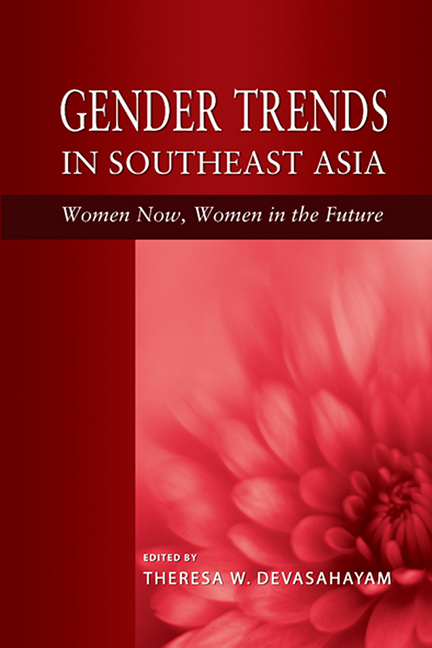Book contents
- Frontmatter
- Contents
- Contributors
- List of Tables and Figures
- Foreword
- Message
- Acknowledgements
- 1 Introduction: Women in Southeast Asia: Changes and Continuities
- 2 Women, Marriage and Family in Southeast Asia
- 3 Gender Trends in Migration and Employment in Southeast Asia
- 4 Has Gender Analysis been Mainstreamed in the Study of Southeast Asian Politics?
- 5 Gender Mainstreaming in Health: Mainstream or “Off-Stream”?
- 6 Politicization of Islam in Indonesia and Malaysia: Women's Rights and Inter-Religious Relations
- Index
4 - Has Gender Analysis been Mainstreamed in the Study of Southeast Asian Politics?
Published online by Cambridge University Press: 21 October 2015
- Frontmatter
- Contents
- Contributors
- List of Tables and Figures
- Foreword
- Message
- Acknowledgements
- 1 Introduction: Women in Southeast Asia: Changes and Continuities
- 2 Women, Marriage and Family in Southeast Asia
- 3 Gender Trends in Migration and Employment in Southeast Asia
- 4 Has Gender Analysis been Mainstreamed in the Study of Southeast Asian Politics?
- 5 Gender Mainstreaming in Health: Mainstream or “Off-Stream”?
- 6 Politicization of Islam in Indonesia and Malaysia: Women's Rights and Inter-Religious Relations
- Index
Summary
INTRODUCTION
About twenty years ago, some of us feminist scholars became exasperated at the neglect of gender in writing on Southeast Asian politics and held a conference at Monash University to discuss the matter. As women, we were offended by the invisibility of our sex in political science, and by the discipline's failure to acknowledge that its concepts (for example, class) were gendered. The conference in 1987 gave rise to a book edited by Maila Stivens entitled Why Gender Matters in Southeast Asian Politics, which launched an attack on the political science discipline for its neglect of gender as far as writing on Southeast Asia was concerned. My chapter in that volume analysed a number of mainstream politics texts on Southeast Asia and noted their abysmal lack of interest in anything relating to gender. Two decades later, I am revisiting this question to see what, if anything, has changed. When we held our earlier conference, feminism had only just begun to influence the study of Southeast Asia. Many feminist works relevant to Southeast Asian politics have now been written, and I will refer to some of them in what follows. Can we now see their impact on mainstream politics writing?
The task I posed for myself was to examine some mainstream political writing about Southeast Asia in the last five to ten years, roughly since the Asian financial crisis which had considerable political effects in some countries. The question I asked was: If you wanted to find out about Southeast Asian politics during the last decade, what general books (that is, not specifically about women) would you turn to and would they tell you anything about women or gender? Since there are very few general books on Southeast Asian politics, I also chose to look at some political science works on the three Southeast Asian countries with which I am most familiar: Indonesia, Malaysia and Vietnam.
- Type
- Chapter
- Information
- Gender Trends in Southeast AsiaWomen Now, Women in the Future, pp. 53 - 72Publisher: ISEAS–Yusof Ishak InstitutePrint publication year: 2009

